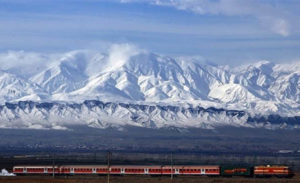September 01, 2017

A Russian bank has agreed to provide 1 billion euros ($1.16 billion) to electrify a 500-kilometer rail line in northern Iran, the Islamic Republic News Agency (IRNA) has quoted a senior official as saying. But this is the third report of financing for the project.
IRNA reported the head of the Islamic Republic of Iran Railways for the northern network, Yusef Gheranpasha, said the unnamed bank would finance the electrification of the line between the cities of Garmsar and Gorgan.
However, only days earlier Gheranpasha was quoted by IRNA as saying the World Bank had agreed to provide the money. The World Bank immediately denied that, saying, “We are not considering financing any projects in Iran right now.”
The failure of Gheranpasha to name the Russian bank providing the loan raised questions as to whether an agreement had really been finalized.
“With the agreement of the Russian bank to provide finance, the project will soon be put into the implementation phase and become operational within three years,” Gheranpasha was quoted as saying.
The loan is related to a 1.2 billion euro deal that Russia and Iran signed to electrify the Garmsar to Inche Burun line during a visit by Russian President Vladimir Putin to Tehran in November 2015, almost two years ago. The railway line extends into Turkmenistan and Kazakh-stan and onto Russia.
Extending and modernizing Iran’s rail system is at the top of the Rohani Administration’s priority list.
Russian Railway officials have said the company will start the electrification project in 2018. The contract covers design, sourcing of materials and equipment and construction of 32 stations and 95 tunnels, 7 traction substations, 11 section pillars, 6 duty posts of the contact station and the power supply administration building.
Further adding to the confusion over the financing, news reports earlier said the Russian government would be financing the project as part of its $5 billion credit line for infrastructure projects in Iran.
The Russians have also announced readiness to electrify the 600-kilometer railway route between Tehran and Tabriz, which is also under discussion with German and Italian firms.
One problem is that economic relations with Russia are much talked about but little acted on. Iran and Russia announced four years ago a major trade promotion deal. Nothing has come of it. Officials on both sides said a bank would be created that would allow trade in rubles and rials. But no such bank has yet been set up.
On Saturday, Deputy Oil Minister Amir-Hossain Zamani-nia said Iran would start selling Russia 100,000 barrels a day of crude oil this month, half to be paid for in goods and services and half in euros. Four years ago, that was to be 500,000 barrels a day. But everyone asks why Russia, a major oil exporter, would buy even a single barrel from Iran.
Last month, Russia’s largest manufacturer of locomotives and rail equipment, CJSC Trans-mashholding, signed a 2.5 billion euro deal with IDRO Group in Tehran for the joint production of rolling stock in Iran.
Transmashholding is to hold an 80 percent stake in the joint venture, taking over Iran’s Wagon Pars Company to produce railroad cars. It is among the biggest deals that Iran has signed with foreign companies since the lifting of sanctions.
In July, Iran signed a deal worth 1.2 billion euros with Italy’s state railway company, Ferrovie dello Stato (FS), to build a high-speed railway between Arak and Qom.
Later that month, French transport company Alstom signed a joint agreement for the construction of subway cars in Iran.
The Export-Import Bank of China (EXIM) also signed a $1.5 billion deal to finance the electrification of a high-speed rail line between Tehran and Mashhad.
The projects are all part of Iran’s $25 billion investment roadmap over the next 10 years to modernize and expand the country’s railway network. Under the plan, Iran seeks to stretch the nationwide rail system to 25,000 kilometers by 2025 from under 15,000 kilometers now.